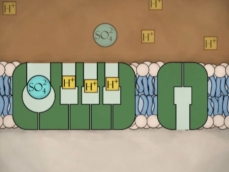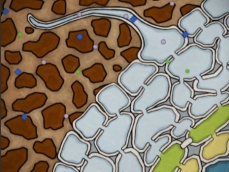Transcription of video clip Cells and nutrients
Soil nutrients
Good tree growth depends on the availability of nutrients found exclusively in the soil: sulphur, potassium, magnesium, nitrogen, etc.

© Jardin botanique de Montréal
There is a lot of water and air in the soil.
The soil seems solid, and is in fact composed of organic and mineral material.
But there is also a lot of water and air around these solid particles.
Soil particles have a negative charge.
Nutrients that are also negatively charged, like phosphates and nitrates, do not bond to the soil.
Positively charged nutrients bond to the soil. They are not available to the roots.
The root thus acidifies the environment by excreting protons and organic acids.
Protons and organic acids thus disperse the clumped nutrients. The latter dissolve in water and are now available.
The root can now absorb the potassium. Passive transport allows it to penetrate the cell: it is an entrance specific to potassium.

© Jardin botanique de Montréal
Soil sulfate absorption by a root cell
To absorb the sulphate, active transport must be used. The root expends energy and expulses protons.
By reabsorbing three protons, the cell draws in precious sulphate. And so on.

© Jardin botanique de Montréal
In green, the endodermis. In yellow, the xylem.
Once nutrients have been absorbed into the periphery, they must travel to the interior of the root.
They pass through the endoderm cells, which control nutrient exchange between root bark cells and its conductive tissues.
Once in the xylem, the precious soil nutrients are transferred throughout the tree by the roots.
Back to video clip




